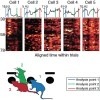Filter
Associated Lab
- Branson Lab (1) Apply Branson Lab filter
- Dudman Lab (3) Apply Dudman Lab filter
- Jayaraman Lab (1) Apply Jayaraman Lab filter
- Remove Karpova Lab filter Karpova Lab
- Looger Lab (2) Apply Looger Lab filter
- Schreiter Lab (1) Apply Schreiter Lab filter
- Svoboda Lab (2) Apply Svoboda Lab filter
- Tervo Lab (9) Apply Tervo Lab filter
Associated Project Team
Publication Date
Type of Publication
14 Publications
Showing 11-14 of 14 resultsFluorescent protein-based sensors for detecting neuronal activity have been developed largely based on non-neuronal screening systems. However, the dynamics of neuronal state variables (e.g., voltage, calcium, etc.) are typically very rapid compared to those of non-excitable cells. We developed an electrical stimulation and fluorescence imaging platform based on dissociated rat primary neuronal cultures. We describe its use in testing genetically-encoded calcium indicators (GECIs). Efficient neuronal GECI expression was achieved using lentiviruses containing a neuronal-selective gene promoter. Action potentials (APs) and thus neuronal calcium levels were quantitatively controlled by electrical field stimulation, and fluorescence images were recorded. Images were segmented to extract fluorescence signals corresponding to individual GECI-expressing neurons, which improved sensitivity over full-field measurements. We demonstrate the superiority of screening GECIs in neurons compared with solution measurements. Neuronal screening was useful for efficient identification of variants with both improved response kinetics and high signal amplitudes. This platform can be used to screen many types of sensors with cellular resolution under realistic conditions where neuronal state variables are in relevant ranges with respect to timing and amplitude.
Regions within the prefrontal cortex are thought to process beliefs about the world, but little is known about the circuit dynamics underlying the formation and modification of these beliefs. Using a task that permits dissociation between the activity encoding an animal’s internal state and that encoding aspects of behavior, we found that transient increases in the volatility of activity in the rat medial prefrontal cortex accompany periods when an animal’s belief is modified after an environmental change. Activity across the majority of sampled neurons underwent marked, abrupt, and coordinated changes when prior belief was abandoned in favor of exploration of alternative strategies. These dynamics reflect network switches to a state of instability, which diminishes over the period of exploration as new stable representations are formed.
Inducible and reversible perturbation of the activity of selected neurons in vivo is critical to understanding the dynamics of brain circuits. Several genetically encoded systems for rapid inducible neuronal silencing have been developed in the past few years offering an arsenal of tools for in vivo experiments. Some systems are based on ion-channels or pumps, others on G protein coupled receptors, and yet others on modified presynaptic proteins. Inducers range from light to small molecules to peptides. This diversity results in differences in the various parameters that may determine the applicability of each tool to a particular biological question. Although further development would be beneficial, the current silencing tool kit already provides the ability to make specific perturbations of circuit function in behaving animals.
Inducible and reversible silencing of selected neurons in vivo is critical to understanding the structure and dynamics of brain circuits. We have developed Molecules for Inactivation of Synaptic Transmission (MISTs) that can be genetically targeted to allow the reversible inactivation of neurotransmitter release. MISTs consist of modified presynaptic proteins that interfere with the synaptic vesicle cycle when crosslinked by small molecule "dimerizers." MISTs based on the vesicle proteins VAMP2/Synaptobrevin and Synaptophysin induced rapid ( approximately 10 min) and reversible block of synaptic transmission in cultured neurons and brain slices. In transgenic mice expressing MISTs selectively in Purkinje neurons, administration of dimerizer reduced learning and performance of the rotarod behavior. MISTs allow for specific, inducible, and reversible lesions in neuronal circuits and may provide treatment of disorders associated with neuronal hyperactivity.

